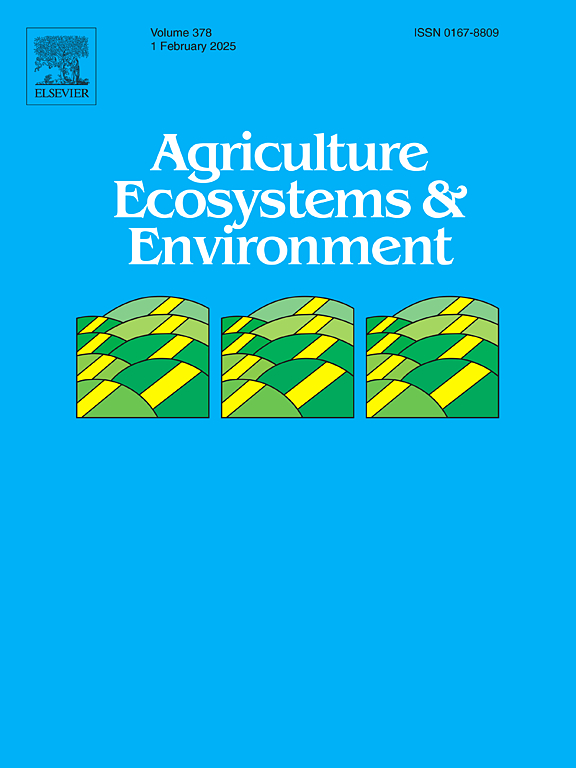A crop yield-based pollination index reveals the impacts of land cover and pesticide use on realized pollination at a landscape scale
IF 6.4
1区 农林科学
Q1 AGRICULTURE, MULTIDISCIPLINARY
引用次数: 0
Abstract
The current pollinator loss raises numerous concerns, because animal pollination maintains the diversity of wild plant communities and is essential for human food. Yet, its consequences for pollination remain unclear, because there is no simple relationship between pollinator abundance or diversity and pollination efficiency. Large scale indicators based on direct measurements of pollination are therefore essential for an accurate assessment of the consequences of pollinator loss for pollination services. Here, we test whether the “realized pollination index” (RPI), a crop yield-based index, is informative on pollination services in a French agricultural landscape. We calculated the index at different spatial resolutions, down to individual fields, compared it with a “potential pollination index” (PPI) based on land cover/land use, and examined its relationship with pesticide use. At the landscape scale, the RPI was positively related to the land cover-based pollination index, and its temporal variations were strongly correlated with those observed at regional or national scales. At the field scale, the RPI was negatively related to pesticide use. These results suggest that the yield-based RPI captures variation in pollination services across landscapes accurately, with large-scale effects of landscape composition, including the spatial arrangement of semi-natural elements and cultivated fields, and more local effects of pesticide use. It could provide an unprecedented, easy-to-use tool for implementing automated pollination monitoring in farmland, from single fields to large areas, and help stakeholders to design biodiversity-friendly territories that efficiently deliver ecosystem services.
以作物产量为基础的授粉指数揭示了土地覆盖和农药使用对景观尺度上已实现授粉的影响
由于动物授粉维持了野生植物群落的多样性,对人类食物至关重要,因此目前传粉媒介的丧失引起了许多关注。然而,其对授粉的影响尚不清楚,因为传粉媒介的丰度或多样性与授粉效率之间没有简单的关系。因此,基于传粉直接测量的大规模指标对于准确评估传粉者损失对传粉服务的影响至关重要。在这里,我们测试了“实现授粉指数”(RPI),一个基于作物产量的指数,是否在法国农业景观中提供了授粉服务的信息。我们计算了不同空间分辨率下的指数,并将其与基于土地覆盖/土地利用的“潜在授粉指数”(PPI)进行了比较,并考察了其与农药使用的关系。在景观尺度上,RPI与基于土地覆被的授粉指数呈显著正相关,其时间变化与区域或国家尺度上的RPI呈显著正相关。在田间尺度上,RPI与农药用量呈负相关。这些结果表明,基于产量的RPI准确地捕捉了景观中传粉服务的变化,包括景观组成的大尺度效应,包括半自然元素和耕地的空间安排,以及更多的农药使用的局部效应。它可以提供一种前所未有的、易于使用的工具,用于在农田(从单个农田到大面积农田)实施自动化授粉监测,并帮助利益相关者设计生物多样性友好型领土,有效地提供生态系统服务。
本文章由计算机程序翻译,如有差异,请以英文原文为准。
求助全文
约1分钟内获得全文
求助全文
来源期刊

Agriculture, Ecosystems & Environment
环境科学-环境科学
CiteScore
11.70
自引率
9.10%
发文量
392
审稿时长
26 days
期刊介绍:
Agriculture, Ecosystems and Environment publishes scientific articles dealing with the interface between agroecosystems and the natural environment, specifically how agriculture influences the environment and how changes in that environment impact agroecosystems. Preference is given to papers from experimental and observational research at the field, system or landscape level, from studies that enhance our understanding of processes using data-based biophysical modelling, and papers that bridge scientific disciplines and integrate knowledge. All papers should be placed in an international or wide comparative context.
 求助内容:
求助内容: 应助结果提醒方式:
应助结果提醒方式:


